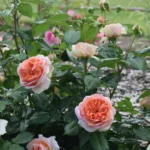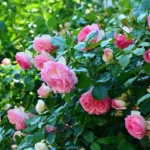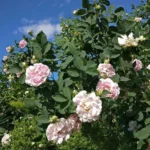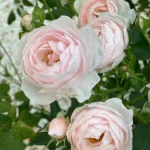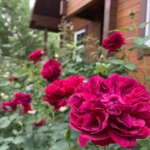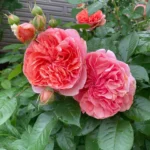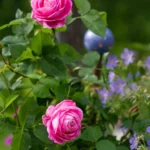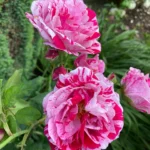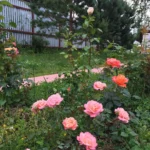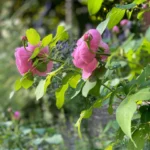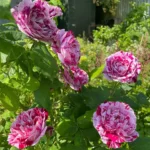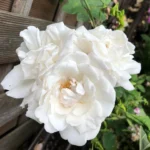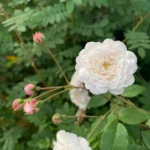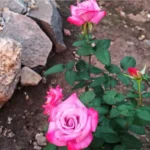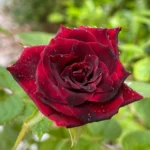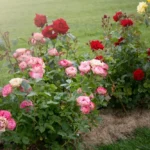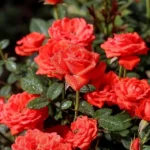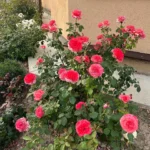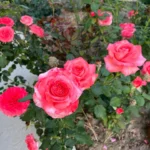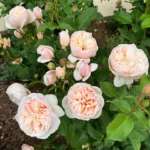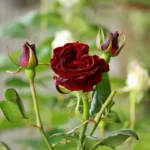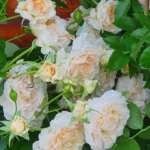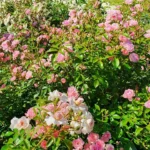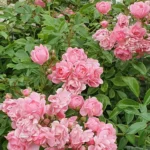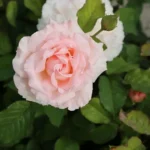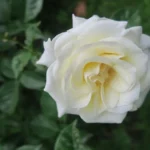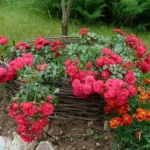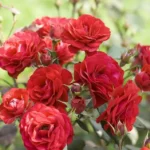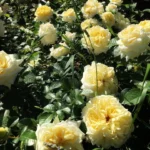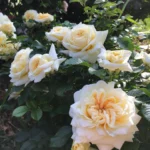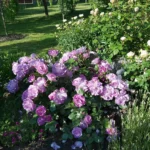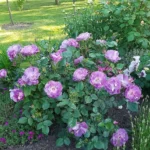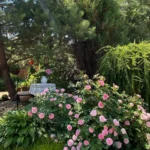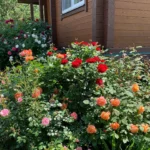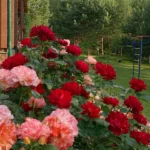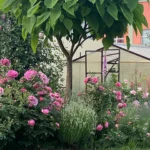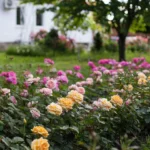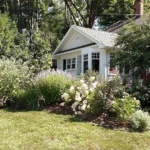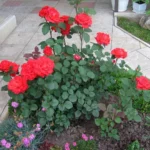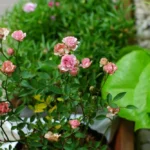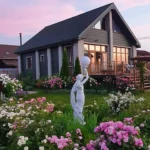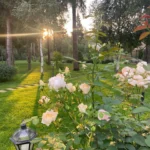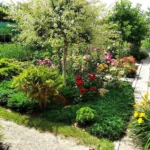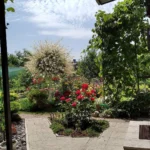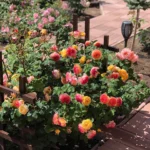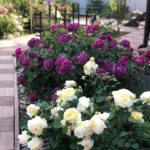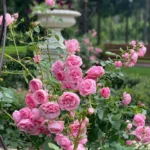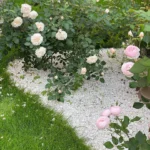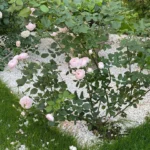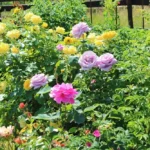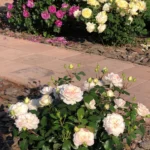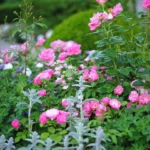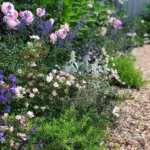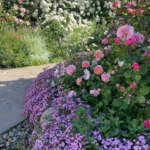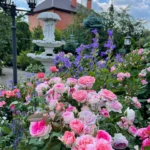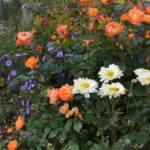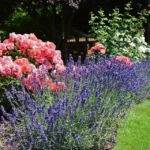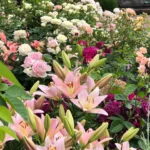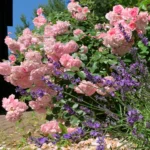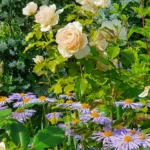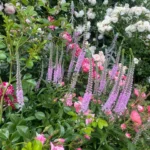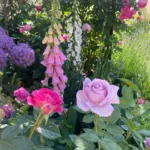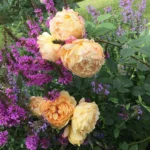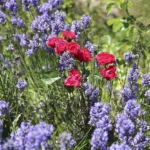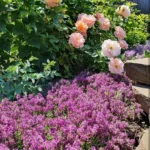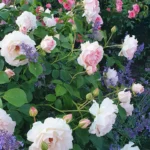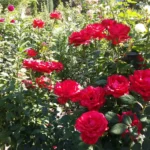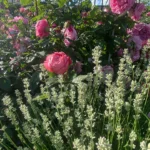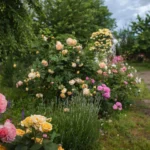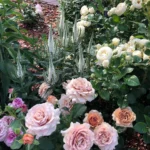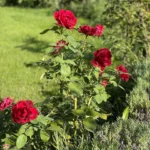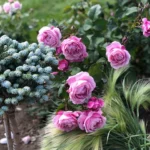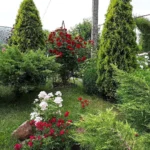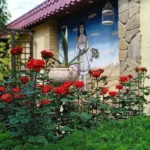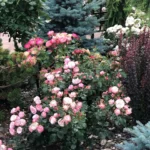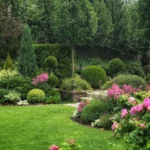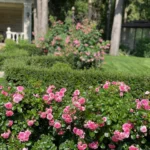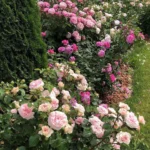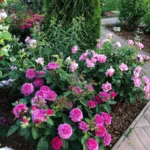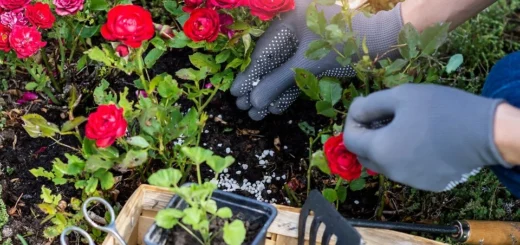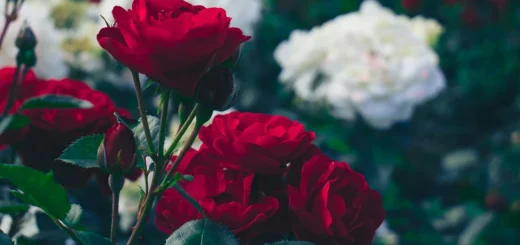Rose bed at the cottage: the best varieties, design ideas, combinations with other plants (80 photos)
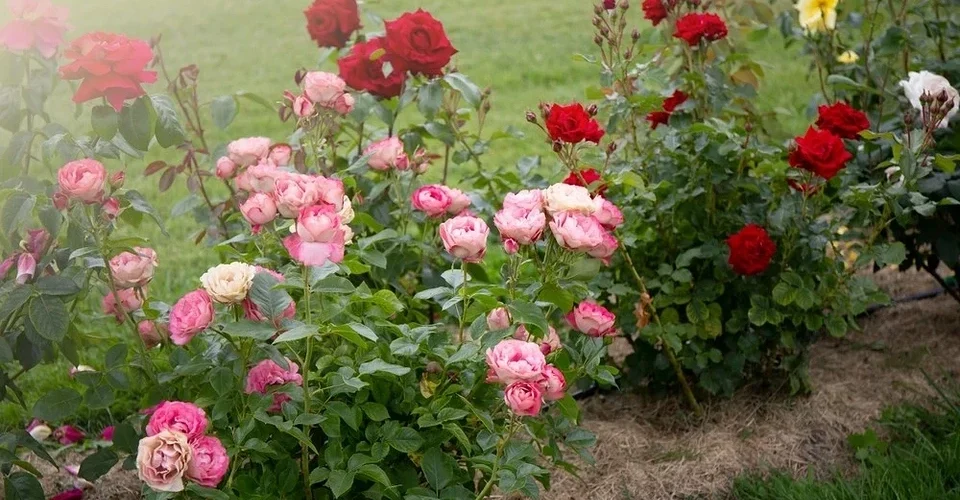
We look for a suitable place, choose varieties, combine them beautifully with flowers, grasses, and shrubs—we have prepared instructions for designing a flower bed with roses.
Roses are the dream of most, if not all, flower growers. A garden with these flowers looks lovely and delicate. But at the same time, creating such a flower bed seems complicated, because the plants are very capricious and require the right neighbors. In this article, we will tell you how to create a rose bed step by step, with photos from real gardens.
Everything about designing a flower bed with roses at your summer cottage
Choosing varieties
There are now a vast number of rose varieties, and with them, dozens of classifications. For example, the most common is by time of origin. All varieties bred before 1867 are considered historical. All those that appeared later are considered modern. In turn, there are further groups within this classification. All types of roses can be divided according to other principles: size, unpretentiousness, winter hardiness, flower shape, etc. Here, we will look at the varieties in general terms to understand which ones are suitable for a particular flower bed.
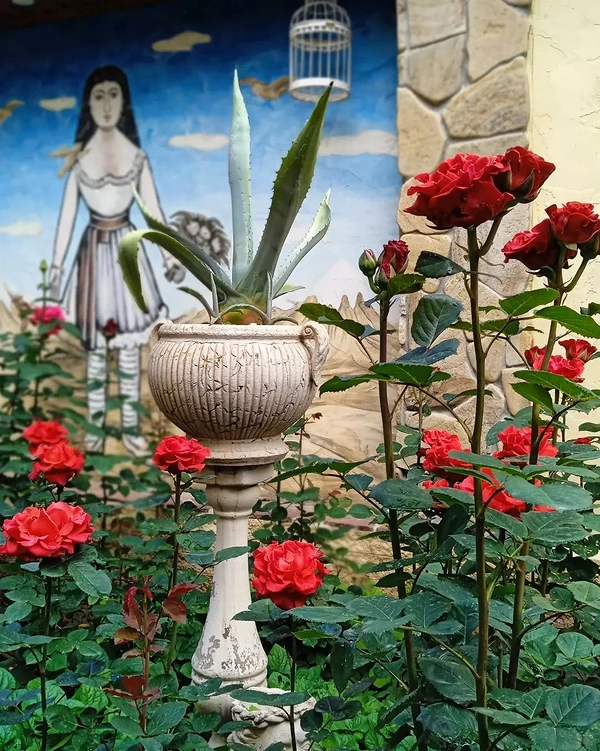
Choosing varieties | Social media accounts of landscape designer Alina Kovsharova
Park
This group mainly includes old varieties, including some decorative rose-hip types. The name reflects the essence of these flowers — they are used to decorate gardens and parks, often over a large area (though this is not required). They rarely get sick, are quite unpretentious, and do not need to be pruned regularly. The flowering period begins in late May, sometimes in June. It occurs once per season, but during this time, you can admire the beautiful inflorescences and enjoy the pleasant aroma.
The park group includes more than 20 varieties. For Zone 4b–5a, the following are best suited:
- Alba Roses — fragrant white or light pink flowers, growing on bushes up to 2.5 m high.
- Centifolia Roses or Cabbage Roses — bushes with voluminous double buds, usually pink in color, but can be red and (very rarely) white.
- Leonardo da Vinci — the result of the work of a French breeder. The bushes are not very tall, up to 1.5 meters, with small pink inflorescences.
- Chippendale (aka Music Hall) — beautiful, rounded buds; there can be several of them on one shoot. The petals come in different colors: from pinkish-white to pastel orange.
- Abraham Derby — unlike most plants in the park group, it blooms twice a season. The buds are large, light in color, and have a bright, fruity aroma.
- Park | Social media accounts of blogger madara_putnina
Repeat-flowering
This type includes tall, spreading, vigorous shrubs that reach about 6.56 feet (2 meters) in height (sometimes more). They bloom profusely and, importantly, twice a season: in June and towards the end of summer. Therefore, if you want to create a flower bed that continues to flower, this is an excellent option.
The buds come in different colors: from white to red and yellow. They exude a light, pleasant aroma. Repeat-flowering varieties are quite winter-hardy but susceptible to fungal disease, so you need to keep a close eye on their condition. The most popular varieties include Heinrich Münch, Marie Baumann, George Dixon, and Ferdinand Pichard.
- Repeat-flowering | Social media accounts of blogger helenfredholm
Tea hybrids
The most popular and numerous group. Tea hybrid flowers are the result of crossing Chinese tea varieties with remontant varieties: they are famous for their unpretentiousness, can withstand frost (though some species need shelter), and are therefore suitable for landscaping summer cottages. They are small bushes ranging in height from 19.7 to 39 inches (50 cm to 1 meter), with strong stems and large single buds. Their colors and scents are varied.
The most popular varieties:
- Gloria Day is considered the most popular rose in the world. It has large flowers with densely double petals, a yellow center, and pink-lilac edging.
- Poinsettia was bred in the late 1930s. The buds have a beautiful goblet shape and exude a faint but delightful scent.
- Black Baccara — dense buds of a dark burgundy, almost black color. The more acidic the soil, the darker it is. Blooms from June to early autumn — continuously and profusely.
- Augusta Louise — rounded flowers change color depending on the climate and weather conditions. The palette is rich, from cream to pinkish-orange.
- Tea hybrids
Ground cover
This type includes low-growing creeping species that cover a large area. They do not require special care, but if you take care of them, they will bloom even more profusely. They are winter-hardy, and some do not even need shelter. They bloom in different ways, and in recent years, varieties have been developed that delight with beautiful buds continuously throughout the summer.
The following species are best suited for Zone 4b–5a: Bonica (will survive without protection down to -22 °F (-30 °F)), Ferdi, Ballerina, Akhtiar, and Concerto.
- Ground cover | Social media accounts of blogger iuliiabalan7
Finding the right spot
The appearance of your rose garden and the well-being of your flowers depend on how well you choose the location.
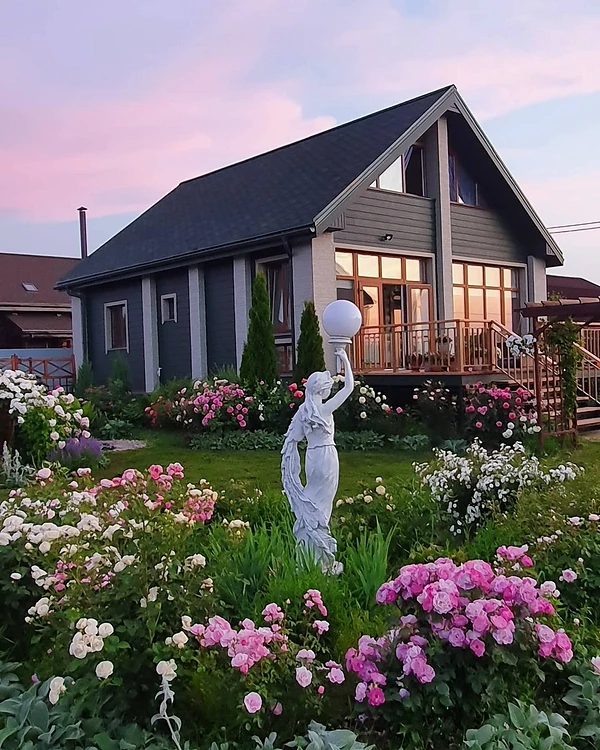
Finding the right spot | Social media accounts of blogger iuliiabalan7
There are two approaches to choosing a site for a flower garden. The first step is to select the species you like, then choose a location based on their specific care requirements. This option is suitable for those who are landscaping a site from scratch or completely redesigning an old one—in general, when there is a choice of where to plant a rose garden. If you only have a specific corner at your disposal, do the opposite: start with the conditions you have and choose varieties that suit them. The same rule applies to which flowers to plant with roses in a flower bed.
So, where can you make a rose garden:
- Most species are sun-loving, so an open, bright clearing is ideal. However, scorching rays and heat are not suitable for any plants, so it is good to have trees growing nearby or a high fence to provide a little shade for the flower garden during the day.
- The plants also need to be protected from strong winds, especially crosswinds. From this perspective, the eastern part of the site is considered the most favorable.
- It is desirable that the flower bed be visible from different angles. If you place it in front of the house’s main entrance, choose a spot that will not damage the flowers.
- You can place the rose garden behind the house and even by the fence, but make sure that the plants are not in the shade all the time.
- If you are planting them near a building, do so at a distance of at least 19.7-23.6 inches (50-60 cm) from it.
- where can you make a rose garden | Social media accounts of blogger liuda_chirko_garden
Deciding on a concept
The next important step is choosing the concept and design for the future rose garden.
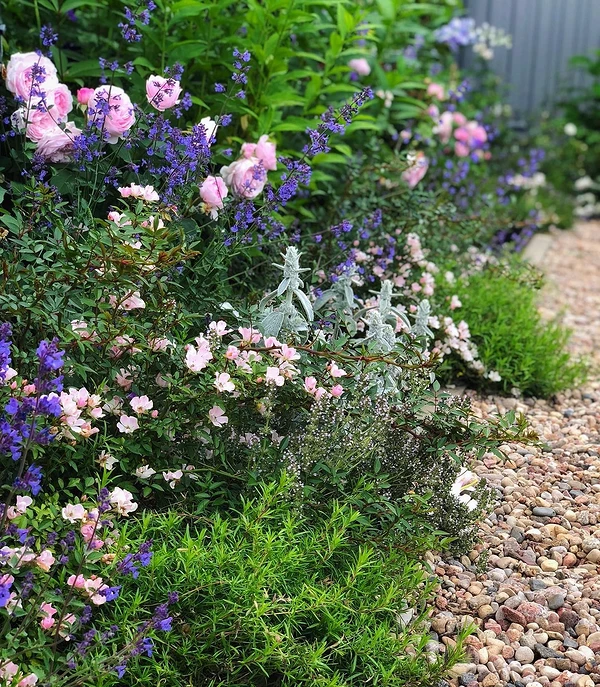
Deciding on a concept | Social media accounts of blogger zelenaya.komnata
First, you’ll need to figure out the style. Usually, it complements the overall landscape design. For flower beds, it is relevant to divide them into regular (strict forms, clear boundaries, symmetry) and landscape (naturalness, planting “as in nature,” slight carelessness). Due to the variety of species, roses are suitable for both directions: you need to choose the right flowers.
The second point is the composition of the flower bed. The first option is a monoclumb, which consists of only one type of plant. There can be several varieties, but within the same family. An example of how to plant such roses beautifully is shown in the photo below. The second option is a combination of several types of flowers in one flower bed. Such a flower bed looks interesting and impressive, but it is essential to choose the proper companions for the rose bushes.
- Deciding on a concept | Social media accounts of blogger marina_bozhenko_
What to plant next to roses in a flower bed
When planning what to plant with roses in a flower bed, consider two equally important factors: neighbors should match the flowers aesthetically and be suitable for growing conditions. That is, they should be comfortable with the same humidity, soil type, and watering regime. You also need to choose plants that will not “overpower” the roses with their root system and take away all the nutrients. It is even better if the companions stimulate each other’s growth and protect each other from garden pests.
Other flowers
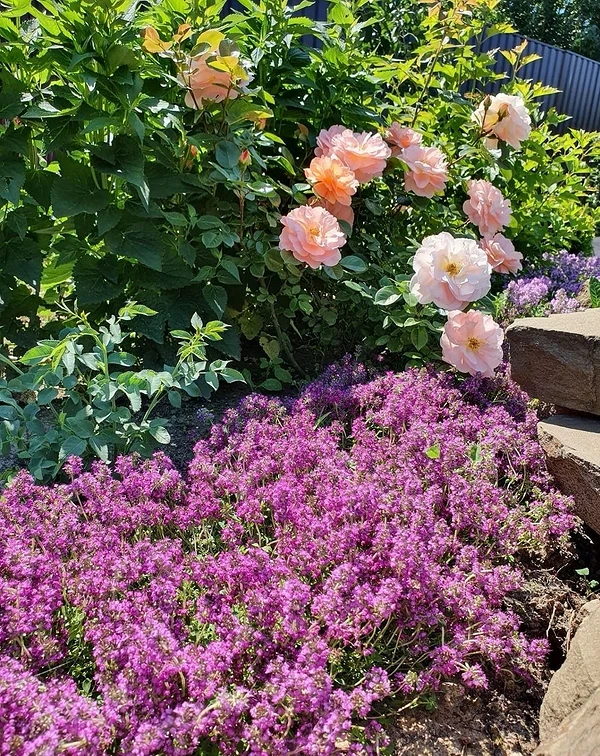
What to plant next to roses in a flower bed | Social media accounts of landscape designer Ekaterina Lisabonova
First and foremost, other flowers are suitable as neighbors. There is a wide selection: from bulbous perennials to field crops. Try to choose ones that differ slightly from roses in terms of flowering period — then the flower bed will delight you not for 1-2 months, but from spring to late autumn.
Here are some recommendations for choosing flowers for a rose garden:
- Bulbous primroses will decorate the flower bed in spring, until the “main characters” bloom.
- Tall, noticeable plants such as mullein, lupine, foxglove, snapdragon, and delphinium are suitable for accent.
- If, on the contrary, you do not want to distract attention from the rose bushes, choose more background varieties: geranium, cosmos, violet, bellflower, etc.
- To fill in the gaps in the flower bed, choose plants with many small buds. These include, for example, gypsophila or lavender.
Don’t forget about color compatibility. Cold tones of lilac, blue, and violet will look spectacular against warm shades. White is universal and can be complemented by any color. Rich scarlet, purple, or burgundy buds are best offset with light neutral tones (cream, pale pink, soft purple).
- What to plant next to roses in a flower bed | Social media accounts of blogger ksu_garden
Herbs and grasses
If you are designing a flower garden in a landscape style and do not want to distract attention from the main features, herbs and grasses are the best companions.
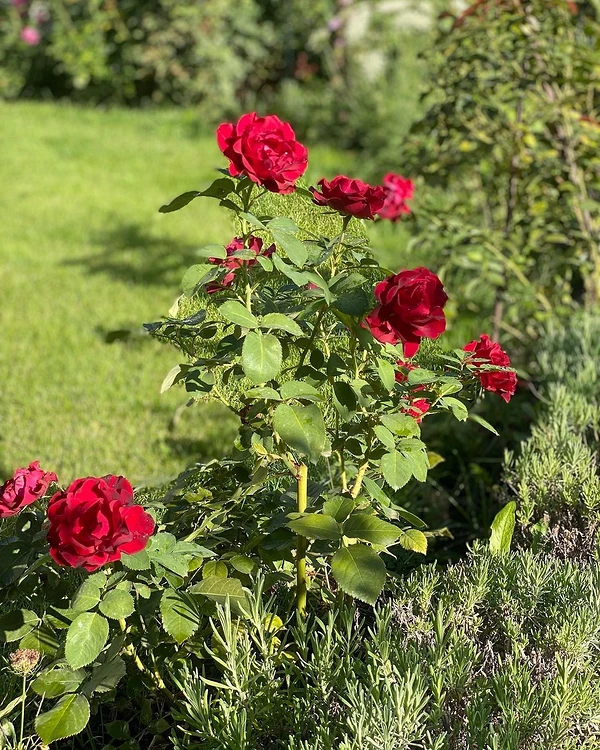
Rose bed at the cottage | Social media accounts of blogger ksu_garden
They will fill the space in the flower bed, yet they will not attract attention and will serve as an excellent neutral background. Plant them around rose bushes, choosing plants of different heights and structures to create volume and a slight sense of carelessness, characteristic of a natural garden. Hostas, pampas grass, miscanthus, feather grass, and phalaris are suitable for this role.
- flower garden in landscape style | Social media accounts of blogger marina_borzhenko_
Shrubs
For a more lush yet visually concise flower bed, choose decorative shrubs.
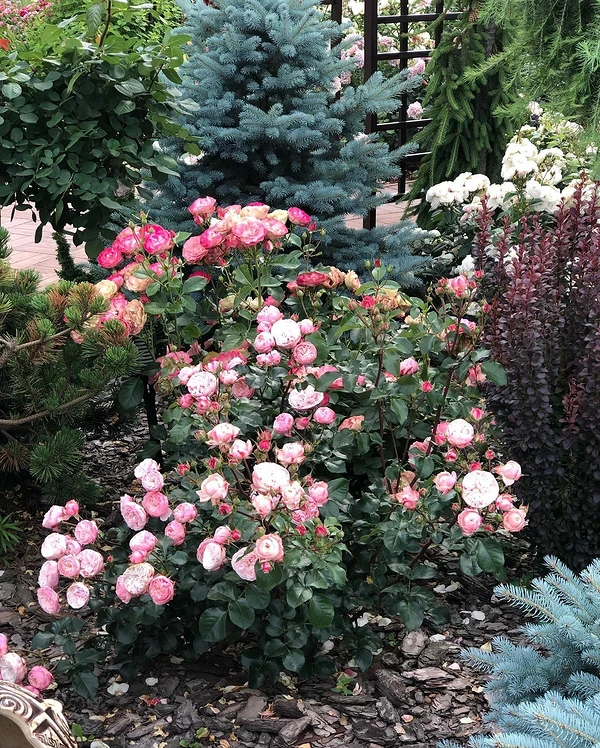
ornamental shrubs | Social media accounts of blogger sad_lady_mary
They can be deciduous or coniferous—both types look good next to roses. They can be arranged in two ways: in the center (in which case you need to choose tall, upward-growing plants) or on the sides of the flower bed as a living border. The best species for a rose garden are juniper, barberry, boxwood, yarrow, cotoneaster, and skunk cabbage. This rose bed design option is appropriate for both landscape and English styles, if you choose shrubs with a precise shape or special varieties for topiary.
- ornamental shrubs | Social media accounts of blogger inna_zherebenko
❓ Questions and answers
How do I choose companion plants to plant alongside my roses?
Select companions that share similar growing conditions (sun, soil, watering) and won’t compete heavily with the roses’ root system. Good options include smaller perennials, grasses, or shrubs that act as background rather than distractions—this creates a richer cottage-garden look.
Where is the ideal location for planting a rose bed in a U.S. garden?
A bright, open spot is best—morning sun with some afternoon shade helps avoid scorch from hot sun. Avoid strong cross-winds and ensure enough distance from buildings (50–60 cm or ~20-24 inches) so the roses get light from multiple angles.
What maintenance tips should I follow to keep a cottage-style rose bed looking its best?
Regular pruning after bloom, removing spent flowers, keeping an eye on fungal issues (especially for repeat-flowering varieties), and ensuring good soil drainage will keep your rose bed healthy. Mulching and companion plants help reduce weed competition and maintain moisture.
Can I adapt a rose bed design for smaller U.S. backyard spaces?
Yes. Choose compact rose varieties (such as tea hybrids or more miniature shrub roses) and mix with low-growing ground covers or small shrubs. Use selective planting rather than large, sweeping beds to fit smaller plots, while still following the design principles of a cottage-style arrangement.
Sofia Lorenson: An expert in floriculture and floristry with 10 years of experience. I will help you create the garden of your dreams, which will bloom from spring to fall.
See also
What cannot be planted together: incompatibility table, cheat sheet for gardeners
How to plant grapes in autumn: planting instructions and care tips
A place to relax: how to organize a rest area
A tall hedge instead of a fence. How to create and maintain it
Bright hedges: how to combine shrubs with their surroundings
Caring for roses in spring: a simple 6-point checklist to follow after winter

